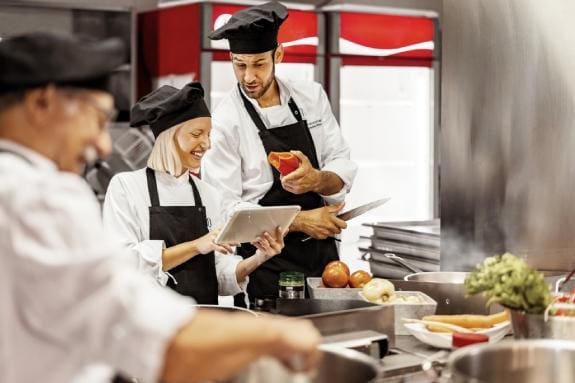From the spice trade of ancient civilizations to today’s viral social media sensations, the food and beverage industry has always been in motion. Trends such as shifting dietary habits, technological innovations, and sustainability concerns have created both challenges and opportunities for industry professionals looking to refresh menus and refine operations. Here’s a look at some of the top food trends shaping the industry in 2025.
What Are Food and Beverage Trends?
Food and beverage trends are the evolving patterns affecting what we eat and drink. They’re a reflection of how consumers select, purchase, and consume products, as well as how businesses produce and market them. These shifts stem from various factors, including economic conditions, technological advances, cultural preferences, and changing consumer values.
Resulting changes take various forms, from the rise of innovative ingredients and preparation techniques to new packaging designs and broader movements in health consciousness. While some trends, such as activated-charcoal-infused beverages and rainbow-colored foods, fade as short-lived fads, others signal longer-term shifts in consumer behavior.
Key Takeaways
- Plant-based alternatives, environmental sustainability, and small-batch production are among the many food and beverage trends.
- Health and wellness is another major trend, encompassing food safety, food quality, provider transparency, and so-called clean labels (food and beverages with short ingredient lists and no artificial ingredients).
- Advanced technological capabilities, such as AI and the Internet of Things (IoT), and sensory science have the potential to redefine everything from product development to daily restaurant operations.
- Affordability remains a top consumer concern, as various factors have contributed to higher-than-average food prices in recent years.
Food and Beverage Trends Shaping the Industry
As social media accelerates the pace of food and beverage trends, business success often requires staying ahead of industry dynamics. From increased focus on health and wellness to technological innovations in food service, today’s trends reflect deeper shifts in how consumers make purchasing decisions and how businesses operate. These changes affect all aspects of the industry, including menu development, ingredient sourcing, packaging choices, and service delivery methods. Here are five main influences that are defining today’s food and beverage industry.
1. Increased Health and Wellness Focus
- Plant-based alternatives: Rather than focusing solely on meat substitutes—which tend to require more processing and more complex formulations, and have fallen out of consumer favor—businesses are exploring innovative uses of plant-based ingredients, such as fava beans, almonds, and lentils, to create simpler formulations at competitive price points. This category is also expanding to include aquatic plants, such as sea moss and agar-agar.
- Functional food and beverages: Some 82% of US consumers prioritize wellness in their daily lives, according to one study. So it’s no surprise that foods and beverages that offer health benefits beyond basic nutrition are driving industry innovation. Product launches featuring digestive health claims are on the rise, with fiber and probiotics two leading ingredient trends. Digestive benefits aside, consumers are increasingly seeking products that support mental wellbeing and skin health, creating opportunities for brands to develop products that address multiple wellness goals.
- Food safety and quality: Eighty percent of Generation Zers prioritize food quality and are willing to pay more for superior products, according to one survey. The emphasis on quality extends beyond taste to include heightened expectations for food safety, defined as the conditions and practices to prevent contamination and foodborne illnesses. In fact, government reports indicate current food safety goals aren’t being met across the fragmented US food supply system. This trend could potentially reshape how businesses approach everything from ingredient sourcing to transparency in manufacturing processes, especially as consumers scrutinize health claims and ingredient lists before making purchases.
2. Sustainability and Eco-Friendly Practices
- Sustainable sourcing and packaging: Sustainability has become an essential business practice, not just an environmental choice. For instance, some companies are beginning to pay more attention to climate-sensitive ingredients, such as cocoa, coffee, and olive oil, as well as sustainable farming methods and climate-resilient crop varieties to ensure long-term supply stability. Consumer demand for environmental responsibility is also pushing businesses to explore alternatives to single-use plastics and develop more sustainable solutions for packaging, storage, and display.
- Zero-waste and circular economy: Driven by both innovative thinking and emerging state regulations, such as New York’s Food Donation and Food Scraps Recycling Law, businesses are beginning to embrace circular economy principles. They’re creating closed-loop systems where food waste becomes a resource. For example, spent grains are turned into flour, citrus peels into flavorings, and food scraps into compost that supports local agriculture. Restaurants are discovering that circular, zero-waste practices offer financial benefits as well as environmental ones.
3. Technology in Food Production and Service
- Automation and AI: AI-powered systems in restaurants and food production facilities can analyze historical sales data and seasonal trends to improve demand forecasting, inventory management, and waste management. Yale University, for instance, is using AI to track and minimize dining hall food waste. Automated equipment, from robot chefs to precision ovens, reduces variability in food quality while cutting back on labor costs.
- Smart kitchens and IoT: Another restaurant technology trend is smart kitchens powered by the Internet of Things. IoT-enabled refrigeration units, for example, track temperature fluctuations to prevent spoilage, while connected cooking equipment enables precise timing to support consistency. These systems also generate data that can be used to refine operations and detect maintenance issues before they become costly problems.
- Interactive menus: Interactive digital menus can boost customer engagement through high-resolution photos, videos, and detailed dish descriptions, as well as provide instant access to detailed nutritional information and suggest food and beverage pairings. Interactive menus also let restaurants quickly update seasonal offerings and promotions without incurring the cost of reprinting.
4. Consumer Preferences and Changing Habits
- Convenience and ready-to-eat options: Convenience and ready-to-eat foods, not known for their quality, are poised for an upgrade. Following the success of Japanese konbini (convenience stores), gas stations and convenience chains are elevating their quick-service items with made-to-order meals, high-quality sandwiches, premium-coffee bars, and locally sourced ingredients. The prepared-meal delivery market is forecast to reach $30 billion in revenue by 2029.
- Direct-to-consumer distribution: Food and beverage companies are adopting direct-to-consumer (D2C) distribution models instead of relying solely on conventional retail partnerships or third-party platforms. This shift is spurred by increasing competition from D2C startups and big-box retailers’ expansion of private-label products, the latter of which has infringed on available shelf space for established brands. Selling directly to customers gives businesses better control over product presentation, as well as the ability to collect more detailed consumer data, build stronger customer relationships, and maintain higher profit margins.
- Transparency and clean labels: One study finds that 69% of consumers support stricter guidelines for food and beverage labeling at grocery stores. Despite the industry’s efforts to inform through certifications, however, 37% of consumers find these certifications confusing, highlighting the need for clearer communication. This, in turn, has led to a growing emphasis on clean labels listing minimal, recognizable ingredients.
- Sensory science: Sensory science is a discipline that considers how multiple senses—from taste and texture to sound and visual aesthetics—influence the consumer experience. Food and beverage producers are using AI, biometric tools, and other advanced technologies to analyze consumer responses to flavors, textures, and aromas, helping them refine their products.
- Affordability: Labor shortages, rising transportation costs, supply chain disruptions, and climate- and health-related events, such as droughts and avian flu, all contribute to increasing food costs. As a result, people are cutting back on dining out, choosing quick-service options over full-service restaurants, and seeking value-oriented products at grocery stores.
5. Alcohol and Beverage Innovations
- Craft beverages and small-batch production: The craft beverage movement continues to unfold. After craft breweries went mainstream in the late 1990s and early 2000s, craft spirits, cocktails, and nonalcoholic options are now having a heyday. Consumer demand for unique, quality flavors and local production is pushing small-batch production to the forefront. Producers can keep a closer eye on quality control, experiment with innovative flavors and styles, and minimize risk through smaller test runs. The trend is emphasizing storytelling and community connection. For example, some producers are focusing on sustainability practices and local sourcing as a way to appeal to environmentally conscious consumers.
How Businesses Can Adapt to Food and Beverage Trends
Businesses need to prioritize flexibility and data-driven decision-making. That begins with conducting market research and monitoring industry trends and progresses through reading industry reports and analyzing social media sentiment and customer feedback. Companies that adapt successfully often do so by testing new concepts through limited-time offerings and small-batch runs before making larger investments.
Food and beverage trends go beyond niche, viral ideas. Investing in modern enterprise resource planning (ERP), inventory management, and interactive ordering systems can automate workflows, reduce waste, and speed up service. At the same time, businesses need to address growing consumer demand for sustainability and transparency by clearly communicating their environmental endeavors and their ingredient sourcing. Of course, food and beverage innovations that align with a business’s brand values and its customers’ preferences will always have greater staying power than fleeting fads.
Navigate Food and Beverage Industry Trends With NetSuite
NetSuite’s cloud-based ERP system for the food and beverage industry gives businesses the tools they need to stay competitive. Using the system’s inventory management, order processing, and customer relationship management capabilities, food and beverage companies can streamline their sales cycles and trace product sourcing for safety and compliance. The system’s quality management capabilities help maintain consistent product standards, and real-time production control and warehouse management features help support efficient operations and reduce waste.
#1 Cloud ERP
Software
Food and Beverage Trends FAQs
What are the future trends in beverages?
Among the many industry trends are nostalgic cocktails with modern twists (dubbed “newstalgia”), reinvented sodas, and immersive, hands-on marketing strategies, such as pop-up tastings and interactive installations.
What is the fastest growing food trend?
While it’s hard to pinpoint a single, fastest-growing trend. among today’s most popular ones are spicy and complex heat flavors, plant-based innovations, environmentally sustainable products, and transparent labeling.
What is the biggest change in the food industry?
One of the most impactful changes in the food industry has been the rise of ecommerce and online food ordering for delivery.









